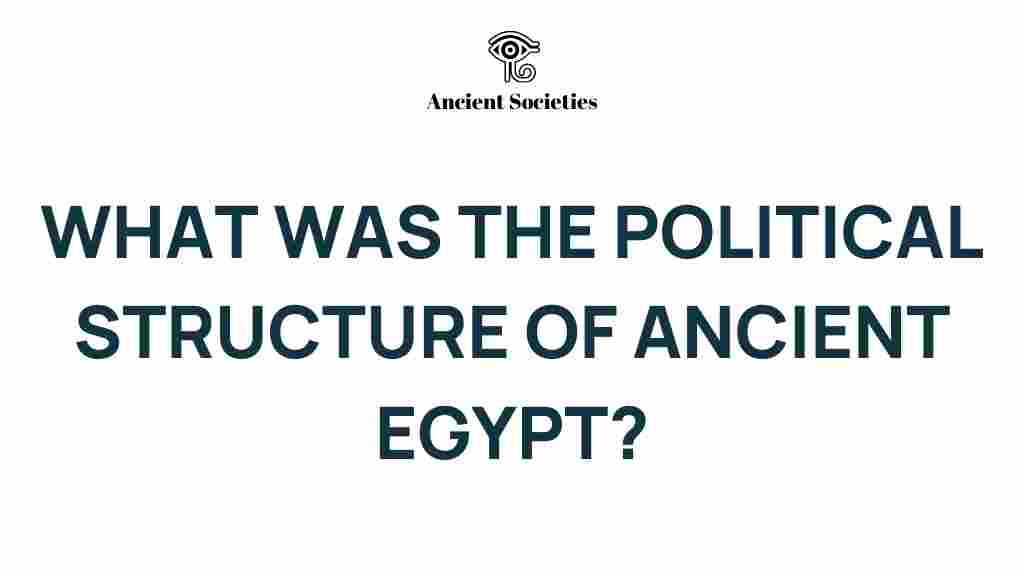Unveiling the Intricacies of Ancient Egypt’s Political Structure
The political structure of Ancient Egypt is a fascinating aspect of its history, showcasing a sophisticated system of governance that has captivated historians and archaeologists alike. From the reign of the Pharaohs to the intricate bureaucracy that supported them, the political landscape of this ancient civilization played a crucial role in shaping its society and culture. This article delves into the complexities of Ancient Egypt’s political structure, exploring its governance, the power of the Pharaohs, and the various dynasties that ruled this remarkable civilization.
Understanding the Governance of Ancient Egypt
The governance of Ancient Egypt was highly centralized, with the Pharaoh at the apex of the political structure. The Pharaoh was not only the political leader but also a divine figure, believed to be the intermediary between the gods and the people. This dual role reinforced their authority and legitimized their power.
- Pharaoh: The supreme ruler, viewed as a god on earth.
- Vizier: The chief advisor to the Pharaoh, responsible for overseeing the administration.
- Bureaucracy: A complex system of officials and administrators who managed different aspects of governance.
- Nobility: Wealthy landowners and officials who held power and influence.
The Role of the Pharaohs in Ancient Egypt
The Pharaohs were central to the political structure of Ancient Egypt. Their reigns marked significant periods in Egyptian history, often categorized into various dynasties. The Pharaohs were viewed as the embodiment of Ma’at, the ancient Egyptian concept of truth, balance, and cosmic order. This belief system was crucial in maintaining social stability and governance.
Key responsibilities of the Pharaoh included:
- Maintaining the favor of the gods through rituals and offerings.
- Implementing laws and ensuring justice throughout the land.
- Overseeing the construction of monumental architecture, such as temples and pyramids.
- Leading the military in times of conflict.
The Bureaucratic System of Ancient Egypt
The bureaucracy of Ancient Egypt was essential for the effective governance of this vast civilization. It was composed of various officials who were responsible for different administrative tasks. The structure allowed the Pharaoh to manage resources, collect taxes, and maintain public order across the kingdom.
Key components of the bureaucracy included:
- Nomarchs: Governors of the provinces (nomes) who reported directly to the Pharaoh.
- Scribes: Educated individuals responsible for record-keeping, tax collection, and legal documentation.
- Priests: Played a dual role in both religious and administrative capacities, overseeing temple economies.
The Social Hierarchy in Ancient Egypt
The political structure of Ancient Egypt was intertwined with its social hierarchy. Society was divided into distinct classes, each with its own role and responsibilities. This stratification reinforced the political framework and ensured a level of organization and stability.
- Royalty: The Pharaoh and his family, who held the highest status.
- Nobility: Wealthy landowners and high-ranking officials.
- Artisans and Merchants: Skilled workers and traders who contributed to the economy.
- Farmers and Laborers: The largest class, responsible for agricultural production.
- Slaves: Often prisoners of war or debtors, who had no rights.
The Dynasties of Ancient Egypt
Ancient Egypt’s history is marked by a series of dynasties, each contributing to the political structure and governance of the state. The most notable dynasties include:
- Old Kingdom (c. 2686–2181 BCE): Known for the construction of the pyramids and the establishment of a strong centralized government.
- Middle Kingdom (c. 2055–1650 BCE): A period of stability and economic prosperity, marked by expansion into Nubia and improvements in irrigation.
- New Kingdom (c. 1550–1070 BCE): The height of Egyptian power, featuring powerful Pharaohs like Ramses II and Hatshepsut.
Each dynasty brought new challenges and changes to the political structure, influencing how power was exercised and maintained.
Power Struggles and Political Instability
Despite its initial stability, the political structure of Ancient Egypt faced numerous challenges, including power struggles, invasions, and internal conflicts. These issues often led to periods of political instability.
Common causes of instability included:
- Succession crises: Disputes over who should inherit the throne.
- Invasions: External threats from neighboring civilizations, such as the Hyksos and later the Assyrians.
- Corruption: Abuse of power within the bureaucracy leading to mismanagement.
Modern Perspectives on Ancient Egyptian Governance
Today, scholars continue to study the political structure of Ancient Egypt to gain insights into its governance and society. Archaeological discoveries and textual evidence provide valuable information about how power was structured and maintained.
Researchers utilize various methods to analyze the governance of Ancient Egypt:
- Archaeological excavations: Uncovering artifacts and structures that provide context to political power.
- Textual analysis: Studying hieroglyphics and inscriptions that document administrative practices.
- Comparative studies: Examining other ancient civilizations to draw parallels and contrasts.
Challenges in Understanding Ancient Egyptian Governance
While much has been learned about the political structure of Ancient Egypt, several challenges remain in fully understanding its governance:
- Incompleteness of records: Many documents from ancient times have been lost or damaged.
- Interpretation of hieroglyphs: Deciphering ancient texts can be complex and subject to varying interpretations.
- Bias in historical accounts: Accounts from later periods may reflect the political agendas of those writing them.
Conclusion
The political structure of Ancient Egypt was a complex web of power, governance, and social hierarchy that evolved over thousands of years. The Pharaohs, supported by a robust bureaucracy and a well-defined social structure, managed to create a civilization that left a lasting legacy on human history. Understanding these intricacies provides valuable insights into not only Ancient Egypt but also the nature of political power and governance in general.
For those interested in a deeper exploration of this topic, further reading can be found in resources such as The Oxford History of Ancient Egypt or by visiting local museums showcasing Ancient Egyptian artifacts.
In summary, the political structure of Ancient Egypt exemplifies a unique blend of governance, religion, and society that has influenced many aspects of civilization throughout history.
This article is in the category History and created by AncientSocieties Team
